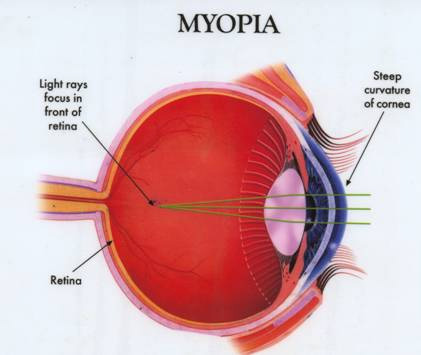REFRACTIVE ERRORS OF THE EYE
What is Myopia?
 Nearsightedness, or myopia, as it is medically termed, is a vision condition in which near objects are seen clearly, but distant objects do not come into proper focus. Nearsightedness occurs if your eyeball is too long or the cornea has too much curvature, so the light entering your eye is not focused correctly.
Nearsightedness, or myopia, as it is medically termed, is a vision condition in which near objects are seen clearly, but distant objects do not come into proper focus. Nearsightedness occurs if your eyeball is too long or the cornea has too much curvature, so the light entering your eye is not focused correctly.
How is it detected & treated?
A sign of nearsightedness is difficulty seeing distant objects like a movie or TV screen or chalkboard. A comprehensive optometric examination will include testing for nearsightedness. Your eye doctor can prescribe eyeglasses or contact lenses to optically correct nearsightedness by altering the way the light images enter your eyes. You may only need to wear them for certain activities, like watching TV or a movie or driving a car, or they may need to be worn for all activities. LASIK laser procedures are also possible treatments for nearsightednessafter the age of 18.
What is Far sightedness (Hypermetropia)?
It is the opposite of myopia. Here initially there will be difficulty in reading & with higher numbers, even distance vision will become blurred.
This should not be confused with Presbyopia, which also causes difficulty in near vision after the age of 40 yrs. This is an ageing process & glasses for near work is the remedy. LASIK laser will not correct Presbyopia.

What is ASTIGMATISM?
In Astigmatism, the curvature of the front part of the eye, the Cornea, will be unequal in the horizontal & vertical axes. Hence the rays of light coming from the horizontal & vertical axes do not meet at a single point. Vision is blurred in one axis & clear in the perpendicular axis.
MYTHS ABOUT SHORT SIGHT
- Eating carrots & eye exercises cure myopia?
NO. Eye power will not change by eating a good diet or by doing exercise.
- Watching TV & too much of reading will cause short sight
NO. Watching TV causes eye strain but will not increase the short sight
- Wearing glasses will prevent the number from increasing
NO. Eye number will increase with the growth of the eye ball irrespective of use of glasses.

